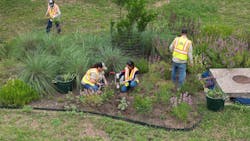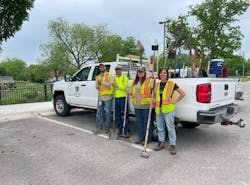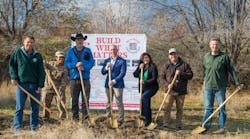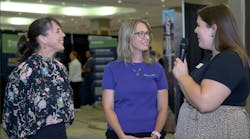Introduction
As growth in Central Texas continues to surge, the city of San Marcos works hard to maintain a beautiful town with natural spaces and a clean flowing river for residents and visitors to enjoy. Part of this effort is through the Stormwater Management Program where Low Impact Development (LID) is playing a larger role in managing the city’s runoff. City stormwater crews are challenged to keep up with the tremendous growth in drainage infrastructure (186% increase in underground pipe in five years) and maintain the entire system. The city is putting all the lessons learned through conferences, webinars, and training into “Pop the Top off LID.” LID practices, if embraced fully, have many benefits for water quality, runoff management, enhancing public spaces and providing habitat for pollinators and wildlife. The San Marcos staff embraced several novel approaches to supercharge their LID program.
LID maintenance program
It all began with a novel approach to fund the LID program and the drainage system maintenance. The engineering and public works departments recognized early on the need to maintain LID practices to provide optimal functionality and appearance. The departments began an initiative to capture 3% of the cost for capital improvement projects to set aside for all infrastructure maintenance. The 3% funding begins after the two-year warranty period on each new project, and will continue perpetually, thus allowing the funding to grow as new infrastructure increases.
The Stormwater Systems Manager, Adam Rossing, and a local environmental engineer Elizabeth (Lisa) Arceneaux teamed up to kick off the city’s LID Maintenance Program. The experience of this team conducting maintenance on other LID practices yielded key information that helped the program take shape.
The LID manual presented a different approach to maintenance in several key areas. The first area was in identifying and listing the practices to determine labor hours needed. LID assets were added to a database where basic information was collected (asset ID, year installed, type of practice, size in ft2, location). Each practice was given a name and photo to clearly identify its characteristics and location. The primary LID practices were rain gardens, biofiltration areas, permeable pavements, engineered wetlands and a modular wetland.
For the infiltration practices, data from past projects were used to determine a unit rate (hours/ft2) to perform routine maintenance and restorative maintenance. Routine maintenance was defined as the activities needed once every two weeks, and restorative was for once every four weeks. For infiltration to perform best, routine and consistent care (at least every two weeks) make up the preferred maintenance schedule. This method of maintenance results in less labor hours overall than trying to restore the practice every four weeks or longer.
By using the unit rates (hours/ft2) multiplied by the size (ft2), the team calculated the hours needed for each practice and the total hours needed for all the practices for routine and restorative care. This provided an approximate workload for the program and gave the stormwater systems manager an idea of the labor needed.
The second key area of difference in the maintenance manual was the site-specific task sheets for each asset. Rather than providing a general list of tasks for rain gardens and permeable pavements, for example, the manual provides a specific list of tasks to perform every two weeks on the specific plants and features at each of the LID practice locations. The City Horticulturist in the Community Enhancement Department provided valuable plant identification and care instructions for the LID Maintenance Manual. The task sheets list the site-specific plantings and care and address other issues such as fire ants, graffiti, litter and other items noted by the crew. This extra attention to detail for plant care is useful for rain garden health, training new staff, creating signage for public education, and creating an informed LID maintenance crew.
A third component of the LID program was scheduling the maintenance to achieve routine, consistent care. Based on the number of hours each practice required, and the number of people hours available each week (crew size), the LID practices were divided into weeks to match those requirements and availability. All of the practices were fitted within two weeks, then repeated. So, each month would have Week 1 and Week 2 practices which repeated for Week 3 and Week 4.
The Stormwater Systems manager creatively staffed the LID Team using another novel approach. First the crew leader was identified and selected from the existing drainage crew staff. The remaining three to four crew members were selected from a pool of candidates who were referred to the manager with agriculture, geography, native plant knowledge and environmental sciences backgrounds.
With the success of the new program and securing the needed funds, the temporary positions were approved for permanent full-time positions in just seven months. During this time, the LID Team received on-the-job training from the crew Leader, the environmental consultant, the city horticulturist, and city arborist. Topics covered were specific LID maintenance tasks, native plant and invasive plant identification, correct mulch to use, native plant resources, tree care, outfall inspection during rain events, and infiltration testing methods. Infiltration testing was taught for both rain gardens and permeable surfaces (pavers and porous concrete). A vendor demonstration for maintenance of the modular wetlands was also part of the training for the LID Team and engineering staff.
The LID team receives its continuing education from U.S. Environmental Protection Agency and vendor webinars, attending stormwater conferences, and learning more about native plants and pollinator plants from the city’s Discover Center staff and greenhouses. The team, one year after the startup, now consists of four full-time staff with benefits and uniforms, and one part-time (in college) team member. The older repurposed trucks used during year one will be replaced with new trucks this fiscal year, and they have creatively outfitted their trucks to transport all necessary hand tools.
Innovation
This crew works hard to keep the LID practices functioning well and looking their best. Practices they have put into place so far are:
- Designing additional educational signage
- Creating a demonstration prairie
- Truck and tools efficiency
- Boosting plant performance
- Putting “volunteer plants” to work (golden rod, sunflowers, primrose, etc.)
- Working with the San Marcos Discovery Center, city horticulturist, and city arborist for holistic plant and tree care.
For more information, please contact Adam Rossing, Stormwater Systems Manager, recently promoted to the Assistant Director of Public Works, at [email protected] or Lisa Arceneaux, P.E. at [email protected].







